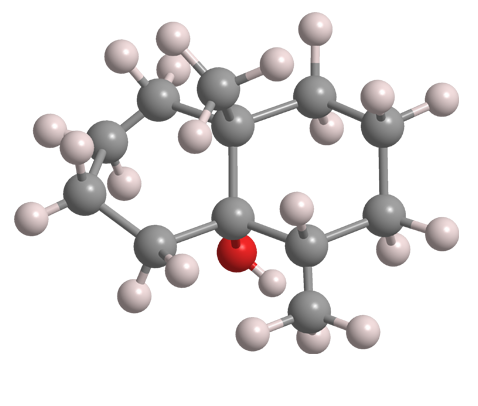What molecule am I?


Geosmin is a natural bicyclic terpene with an earthy odor. According to The Merck Index, it is the “major volatile component of beet essence, also . . . the potent earthy odor contaminant of fish, beans, [and] water.” The human nose can detect it at concentrations in air as low as 5 ppt.
In 1936, A. C. Thaysen at the Chemical Research Laboratory, Teddington (London) described an odorous compound produced by actinobacteria in fishing streams. About 30 years later, Nancy N. Gerber and Hubert A. Lechevalier at Rutgers University (New Brunswick, NJ) isolated it from several Streptomyces spp. They did not determine its structure but named it geosmin from the Greek words for “earth” and “smell”. Biochemist Gerber later elucidated its structure.
Flash forward to 2019, when biologist Marcus C. Stensmyr and postdoc Nadia Melo at Lund University (Sweden) observed that yellowfever mosquitoes (Aedes aegypti) are attracted to geosmin. Their colleagues at Florida International University (University Park) showed that A. aegypti like the odor so much that they lay their eggs in geosmin baits.
Beet peels are rich in geosmin, so Stensmyr engaged a team at the Federal University of Alagoas (Maceió, Brazil) to construct and test a simple trap baited with beet-peel extract. This is a win–win situation because the peel is a waste product. Stensmyr’s next steps are to optimize the trap and observe whether it significantly decreases mosquito populations.
Geosmin hazard information
| Hazard class* | Hazard statement | |
|---|---|---|
| Serious eye damage/eye irritation, category 2A | H319—Causes serious eye damage | |
*Globally Harmonized System of Classification and Labeling of Chemicals.
Explanation of pictograms.
Geosmin fast facts
| CAS Reg. No. | 19700-21-1 |
| SciFinder nomenclature | 4a(2H)-Naphthalenol, octahydro-4,8a-dimethyl-, (4S,4aS,8aR)- |
| Empirical formula | C12H22O |
| Molar mass | 182.30 g/mol |
| Appearance | Colorless solid or oil |
| Melting point | 47 ºC |
| Boiling point | 270–271 ºC |
| Water solubility | 160 mg/L (est.) |
MOTW update:
April 27, 2020
Geosmin is a natural bacterial product that is found in beet peels, among other plant parts. Yellowfever mosquitoes are attracted to beets, so scientists are experimenting with traps baited with the peels. Geosmin is made by Streptomyces bacteria in beets. Swedish scientists have discovered that tiny invertebrates called springtails are also attracted to the geosmin in beets. They help the bacteria reproduce by spreading their spores into the environment.

Learn more about this molecule from CAS, the most authoritative and comprehensive source for chemical information.
Molecule of the Week needs your suggestions!
If your favorite molecule is not in our archive, please send us a message. The molecule can be notable for its current or historical importance or for any quirky reason. Thank you!
Stay Ahead of the Chemistry Curve
Learn how ACS can help you stay ahead in the world of chemistry.

